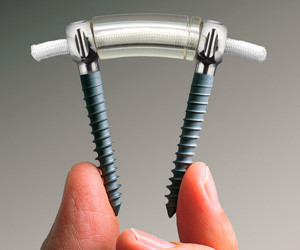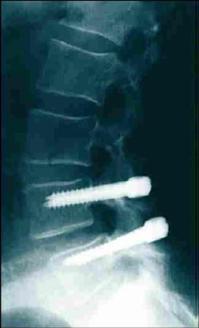Dynesys DSS
Dynesys Dynamic Stabilization System
The Dynesys Dynamic Stabilization System combines the surgical approach of traditional fusion with the philosophy of dynamic stabilization, using flexible materials to stabilize the spine while preserving anatomical structures.
The Dynesys System augments fusion treatment by dynamically stabilizing the affected joints at rest, in flexion and in extension.The Dynesys System is a pedicle screw fixation system intended to provide immobilization and stabilization of spinal segments as an adjunct to fusion in the treatment of acute and chronic instabilities or deformities of the thoracic, lumbar and sacral spine -- including degenerative spondylolisthesis with objective evidence of neurologic impairment and failed previous fusion (pseudarthrosis).
In addition, the Dynesys System is indicated for use in patients who are:
- Receiving fusions with autogenous graft only
- Having the device fixed or attached to the lumbar or sacral spine
- Having the device removed after the development of a solid fusion mass
Once the devices are attached bilaterally to the affected segments, the dynamic push-pull relationship between spacer and cord stabilizes the joints, keeping the vertebrae in a more natural position.
The result is dynamic stabilization that allows the surgeon to preserve much of the spinal anatomy. It accommodates a familiar surgical approach and minimally invasive techniques in a range of patients -- including those with acute and chronic instabilities caused by degenerative changes in the intervertebral discs.
Unlike other pedicle-screw devices, the Dynesys System's screws are placed lateral to the facets. As a result, the surgeon is able to preserve more of the facets than can be spared with conventional pedicle-screw placement.
With the Dynesys System, the surgeon can use a minimally invasive procedure or a posterior approach with typical incision and muscle retraction.
The Dynesys LIS instrumentation is designed to preserve soft tissues and minimize exposure in all surgical approaches.
Because this is a new approach to fusion, Zimmer Spine offers comprehensive training and support; ask your Zimmer Spine representative for information on actual training protocols.
The Dynesys System begins working as soon as it is in place. Intra-operatively, as the spacer warms from room to body temperature, the cord tension decreases between 25% and 33%. Immediately post-operatively and until fusion occurs, it provides stability similar to a posterior fixation system, with AR, LB and FE motion reduced and stiffness increased from pre-operative levels.
Near-term, the cord tension decreases 25% from its post-operative level. Stiffness also decreases while ROM increases. Long-term, the cord tension remains constant at a 50% reduction from intra-operative levels; AR, LB and FE motion are constrained from pre-operative levels.


